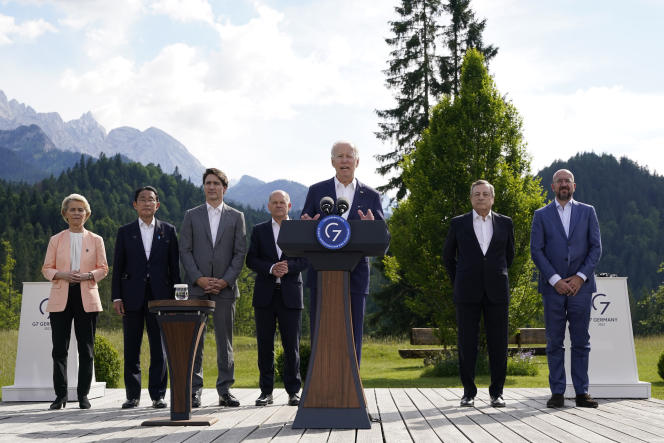The project is supposed to thwart the huge construction sites financed by China in developing countries. At the initiative of the United States, the G7 put on track, on Sunday June 26, a vast investment program for these developing countries.
“With G7 partners, we aim to mobilize $600 billion [just under $570 billion] by 2027 for global infrastructure investments,” the White House said shortly before a speech by Joe Biden unveiling this proposal at the summit of the seven industrialized countries (Germany, Canada, United States, France, Italy, Japan, United Kingdom), which was held in southern Germany.
The President of the United States assured that this program was based on “shared values” such as “transparency”, respect for workers’ rights, the environment, gender equality. “We provide better options,” he commented.
Neither the US president nor the other leaders mentioned China’s name, but they made obvious allusions to it. The President of the European Commission, Ursula von der Leyen, thus considered that the partner countries of the West “[had] the choice” – including that of going to the democracies rather than to Beijing – to develop their electricity networks or their infrastructures. medical.
Westerners want to distance themselves from China, which has invested heavily in many developing countries, to build infrastructure there as part of the so-called “New Silk Roads” program, or to ensure access to certain materials. raw.
US$200 billion over five years
Beijing is nevertheless accused of carrying out its projects by resorting to unprofitable, opaque, even perilous loans, which would aggravate the debt problems of already vulnerable countries. Hence the “transparency” promised, on the contrary, by the G7 countries.
The Partnership for Global Infrastructure must “give the world a better deal on infrastructure investment”, stressed German Chancellor Olaf Scholz. The United States alone promises to “mobilize” some “$200 billion” over five years.
But “mobilizing” does not mean that the states themselves will contribute these considerable sums. Washington arrives at the total of 200 billion dollars by combining loans, public financing – partly already existing – and private financing encouraged by the American executive. With these big numbers still uncertain and these good intentions, can Westerners turn the tide against China? The United States wants to believe it.
The Chinese offensive “has existed for years and has resulted in many cash payments and many investments,” a senior White House official said on Sunday. “But it’s really not too late,” he said of the G7 initiative.
“Many countries that have received funds or investments from the BRI [Belt and Road Initiative] program now realize, years later, that they are more indebted, that their GDP has not grown significantly, that the so-called investments have not reached their populations,” said the same source, who did not wish to be named.
“Sub-Saharan Africa will clearly be a major priority [of the partnership launched by the G7],” the senior US executive said, but assured that Central America, Southeast Asia, or Central Asia were also “extremely important” regions.














